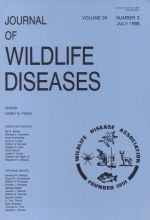One of seven female coyotes (Canis latrans) captured in Webb County, Texas during September 1986 and confined and mated in holding facilities at Millville, Utah whelped the following spring. The maternal female (>5-yr-old) and her five neonates were killed at 22 days postparturition. All were infected with adult Ancylostoma caninum and were passing eggs in their feces. Also, the neonates and maternal female were infected with immature and adult Alaria marcianae, respectively. These findings suggested that the transmammary route is an important transmission mechanism for acquisition of these species of helminths in coyotes. The lack of overdispersion in the frequency distribution of these parasites and infection of the entire litter indicated that transmission from the infected female was nonselective among the pups.
How to translate text using browser tools
1 July 1988
Transmission of Ancylostoma caninum and Alaria marcianae in Coyotes (Canis latrans)
Danny B. Pence,
Frederick F. Knowlton,
Lamar A. Windberg

Journal of Wildlife Diseases
Vol. 24 • No. 3
July 1988
Vol. 24 • No. 3
July 1988
Alaria marcianae
Ancylostoma caninum
Canis latrans
coyote
experimental study
hookworm
intestinal diplostomid digenean




